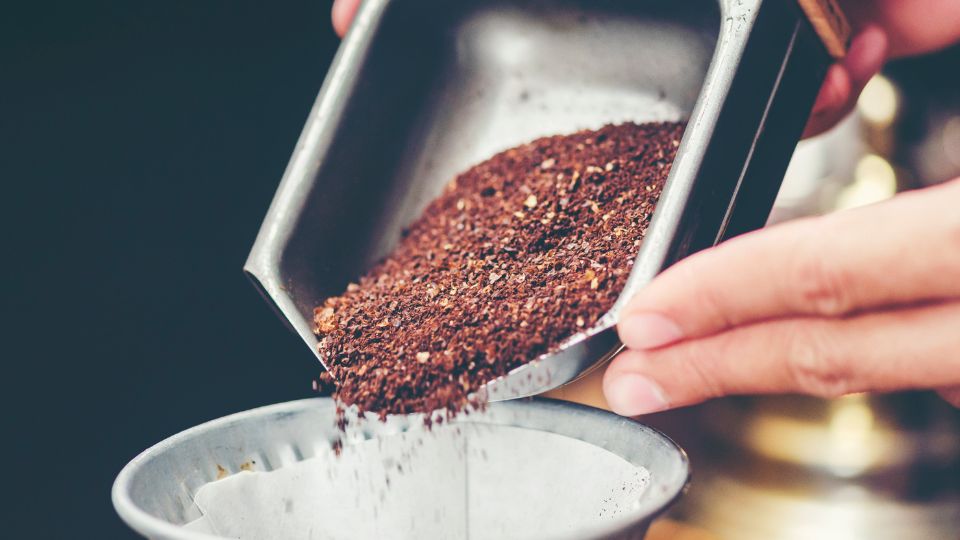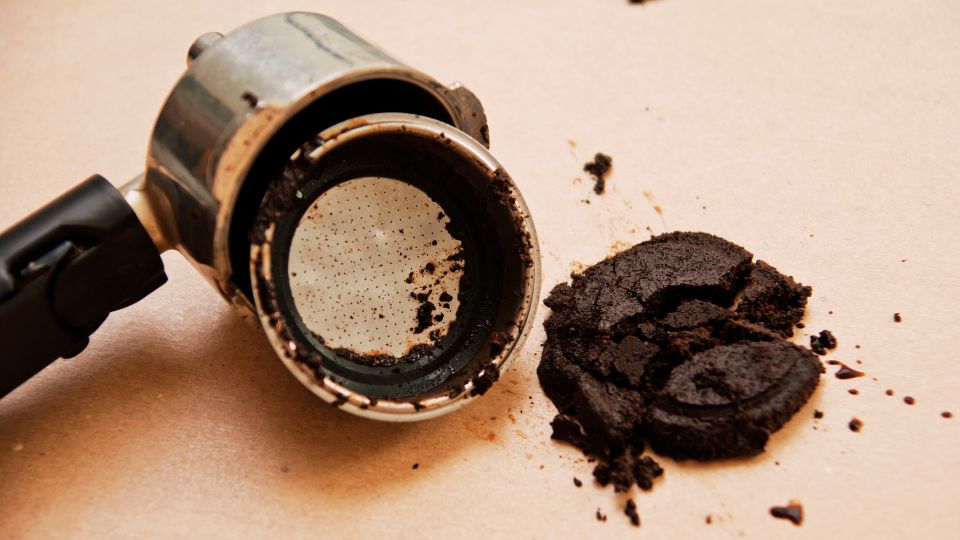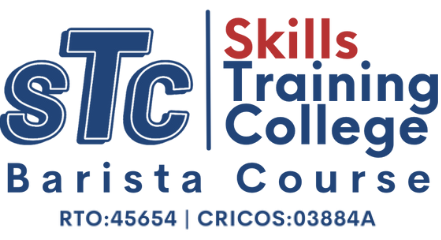Fines migration in espresso is the movement of fine coffee particles towards the centre of the coffee puck during brewing. Fine particles are the smallest particles produced during the grinding of coffee; they are defined as beans with a diameter of fewer than 100 micrometres. This phenomenon can significantly affect the taste and quality of the resulting espresso.
Here’s a quick overview of fines migration:
- Fines migrate when water is forced through a compacted puck of ground coffee beans during espresso brewing.
- Fine particles are smaller than the average grind size. They can move through the spaces between larger coffee particles more easily.
- As water flows through the coffee puck, fine particles migrate to the centre, forming channels that allow water to flow more quickly and unevenly.
- This can result in under-extracted coffee since some puck areas receive less water, resulting in less flavour extraction.
- Fines migration can also result in over-extracted coffee because the channels created by smaller particle movement allow water to flow too quickly through some puck areas, resulting in bitter, burnt-tasting espresso.
- Baristas can prevent fines migration by adjusting the grind size of the coffee, tamping with more even pressure, and distributing the coffee more evenly in the portafilter.
- Baristas can ensure a more consistent and high-quality espresso extraction by preventing fines migration, resulting in a more balanced and flavorful espresso shot.

What Are Fines In Coffee Grounds?
The term “fines” describes the smaller particles resulting from the grinding process in coffee science. These particles can be problematic in coffee brewing because they can lead to decreased fluid percolation, affecting the extraction kinetics of the coffee.
When fines are present, the flow rate decreases. The water may struggle to extract the coffee evenly, resulting in over-extraction and a potentially bitter taste in the cup.
On the other hand, Fines can play a role in coffee brewing. Fines are desirable in espresso brewing because they contribute to the proper level of resistance required to create the perfect shot. Furthermore, fines can contribute to the body and mouthfeel of the coffee, which is desirable in some brewing methods.
Overall, the presence of fines in coffee grounds is an important factor to consider when brewing coffee. While they can contribute to certain desirable qualities, they can also affect the final cup’s taste and texture. Understanding the role of fines in coffee brewing can assist coffee professionals in making informed decisions about the grinding process, resulting in a better cup of coffee.
How Coffee Extraction Occurs?
Coffee extraction is a multi-step process that consists of two major stages:
- Surface erosion and
- Inter-particle diffusion.
Water initially penetrates the outer layer of the coffee grounds during the surface erosion phase, dissolving and carrying away soluble compounds. This happens quickly, usually within the first few seconds of extraction.
The second phase, inter-particle diffusion, involves water migration into the coffee grounds’ cell fragments and particles subject to extraction. Because water must penetrate deeper into the coffee particles to extract the desired compounds, this phase can take much longer. Factors such as particle distribution, particle size, and the water flow rate through the coffee bed all influence the rate of inner-particle diffusion.
The extracted coffee’s quality is determined by several factors, including:
- The time resolved extraction of caffeine,
- Particle migration, and
- Distribution tools used in the brewing process.
Different machines, such as espresso machines and drip coffee makers, use different techniques to control these factors and achieve the desired extraction.
Espresso machines, for example, use high tamping pressures to compress the coffee bed and slow the water flow, whereas drip coffee makers frequently use a shower screen to distribute water evenly over the coffee bed.
Understanding the coffee extraction process is critical for achieving optimal cup quality. Coffee professionals can achieve consistent, high-quality results with every brew by controlling the particle size and distribution, flow rate, and extraction time.

What Are The Effects Of Fines Migration On Temperature In The Coffee Puck?
The effects of fines migration on the temperature of the coffee puck are described below:
|
Effects |
Description |
| Fines migration can create channels in the coffee bed | When small particles migrate through the coffee bed during brewing, they create channels allowing water to flow more quickly through certain areas. As a result, less heat exchange occurs in those areas, resulting in lower temperatures in those areas of the coffee puck. |
| A temperature drop during heat exchange | When hot water comes into contact with coffee, the temperature drops slightly due to heat exchange. When fines migrate and form channels, the water and coffee particles have less contact in those areas, resulting in less heat exchange and lower temperatures. |
| Uneven temperature distribution | Fines migration in the coffee puck can cause uneven temperature distribution. Temperatures may be lower in areas where fines have migrated. Comparatively, temperatures may be higher in areas where fines have not migrated. |
| Lower overall temperature | Extensive fines migration can result in a lower temperature in the coffee puck. As a result, certain compounds may not be extracted properly, lowering the overall quality of the brewed coffee. |
| Impact on brewing methods | Depending on the brewing method used, fines migration can have varying effects on temperature. In espresso brewing, for example, fines migration can result in lower temperatures in the centre of the puck, resulting in under-extracted espresso shots. |
Overall, the temperature of the coffee puck can be affected by fines migration due to the channels it creates, which can have varying effects on the brewing process.
What Is The Role Of Coffee Bed In Fines Migration?
The coffee bed is critical to fines migration, the process by which the smallest particles (fines) migrate downwards through the coffee bed during brewing. The role of the coffee bed in fines migration is described below:
- The coffee bed itself has a significant impact on fines migration. A well-distributed coffee bed can help prevent fines from migrating too quickly. In contrast, an unevenly distributed bed can cause channelling (when water flows too quickly through the coffee) and increased fines migration.
- The type of brewing method used has an impact on the distribution of the coffee bed. Pour-over brewing, for example, necessitates a more precise bed distribution than a French press.
- Fines migration is also affected by the size of the coffee particles. Finer particles are more likely than larger particles to migrate through the bed, so use the appropriate grind size for your brewing method.
- Stirring the coffee bed can help prevent fines migration by redistributing the particles more evenly. It is important, however, to stir gently and not disturb the bed too much.
- Finally, fines migration can be affected by the depth of the coffee bed. A deeper bed can slow fines migration, whereas a shallower bed can accelerate. Again, the appropriate depth will be determined by the brewing method.
Overall, the coffee bed plays an important role in the migration of fines. Distributing the bed evenly and using the proper grind size and brewing method can help produce a better cup of coffee.

What Are The Methods To Minimise Fines?
You can make a better, more consistent pot of coffee by following these guidelines and reducing the number of fines. In order of importance, here are some methods for minimising coffee fines:
- Invest in a good grinder: A good grinder with sharp and properly aligned burrs can grind coffee beans more uniformly, resulting in fewer fines. Investing in a good grinder can significantly improve the quality of your coffee.
- Use the proper grind size: Using the proper grind size for your brewing method can also help to reduce fines. Coarser grinds are generally preferable for methods such as the French press, while finer grinds are preferable for espresso. Using the incorrect grind size can lead to over-extraction, resulting in more fines.
- Avoid using old coffee beans: Coffee beans become more brittle and can produce more fines when ground as they age, so it’s best to avoid using old beans if you can. Using freshly roasted beans can make for a better cup of coffee and fewer fees.
- Using a paper filter: You can prevent fines from making it into your beverage by using a paper filter. Use a metal mesh filter with a tighter weave to help trap fines if you’re making coffee with a method that doesn’t require a paper filter, like a French press.
- Don’t over-grind: Grinding coffee too finely can result in more fines. If you’re getting a lot of fines, try turning your grinder to a coarser setting.
- Stir the coffee bed gently: after pouring water to help distribute the fines more evenly and prevent channelling. Just be careful not to disturb the bed too much, as this may cause fines migration.
Is Fine Grain Vital To The Espresso Extraction Process?
Fine grain is essential in the espresso extraction process because it enables the following:
- Extraction that is consistent and precise: The fine grind size ensures that the water is in contact with the coffee for the appropriate amount of time, resulting in an espresso extraction that is consistent and precise. This is necessary to ensure that the espresso shot’s flavour, aroma, and strength are consistent and repeatable.
- Pressure Optimisation: The fine grind size provides the optimal resistance to the water flow, which is required to generate the necessary pressure for espresso extraction. This pressure aids in extracting the coffee’s oils, sugars, and acids, resulting in a rich and flavorful shot.
- Emulsification: The fine grind size ensures that the coffee particles are small enough to emulsify properly with the water. This is important so that a thick, creamy layer of crema can form on top of the espresso shot, improving the drink’s taste and texture.
- Full extraction: The fine grind size ensures that all the flavours and aromas from the coffee grounds are extracted, resulting in a well-balanced shot with a full-bodied taste.
- Effectiveness: The fine grind size allows for a faster extraction time, making baristas in a busy coffee shop more efficient. This means they can quickly and efficiently produce high-quality espresso shots without sacrificing flavour or quality.
Where Do The Fine Particles Migrate During Espresso Coffee Extraction?
The fine particles (known as fines) in espresso coffee tend to settle to the bottom of the coffee puck due to the compaction forces applied during the tamping process. This is called “coffee channelling.” It happens when water finds the path through the coffee puck with the least resistance, skipping some parts and over-extracting others.

What Factors Affect Fine Particles?
Several factors, including the amount of coffee used, various particle sizes, and the pressure applied by the machine’s pump, can influence the location and distribution of these fine particles.
- The amount of coffee used: The amount used in the basket is an important factor influencing particle migration during extraction. If the dose is too low, the coffee particles may not pack tightly enough, causing the fine particles to migrate to the puck’s edges. If the dose is too high, the puck may become too compact, and the fine particles may cluster in the centre.
- Various particle sizes: Another factor that can influence particle migration is the size of the coffee particles. Coffee particles that are too fine may clog the basket, preventing water from flowing evenly. As a result, uneven extraction and particle migration towards the centre may occur. If the particles are too coarse, the water may flow through too quickly, resulting in a weak extraction.
- The volume of water: How much water is used during the extraction process can influence particle migration. If the volume is too large, the water may flow too quickly through the puck, resulting in poor extraction and increased migration of fine particles to the centre. If the volume is too small, the extraction may be too strong, causing the particles to migrate less.
- Basket: The basket can also influence particle migration. Because smaller holes restrict the water flow and result in a more compact puck, a basket with smaller holes may cause more migration towards the centre. Larger holes in the basket may result in more even extraction and less migration.
- Pressure applied: Finally, particle migration is influenced by the pressure applied by the machine’s pump. Calibration of the pump is required to ensure even pressure across the puck, preventing channelling or uneven extraction. If the pressure is too high, the fine particles will be pushed to the centre of the puck, resulting in over-extraction and bitterness. If the pressure is too low, the extraction will weaken, and the particles will migrate less.
Ensuring these factors are properly calibrated and consistent can result in a more even and balanced extraction.
Does The Presence Of The Tiniest Fines Of Coffee Grounds Damage The Espresso Quality?
The presence of even the smallest fines of coffee grounds impacts the quality of the espresso. Some important considerations are as follows:
- Espresso is made by pressurising water through tightly packed coffee grounds. Uneven extraction can occur if fines in the coffee grounds clog the filter basket and slow the water flow.
- Under-extracted or over-extracted coffee, which results in a sour or bitter flavour, can result from uneven extraction. Even the smallest fines from coffee grounds can affect the consistency of the extraction process, which in turn affects the flavour and quality of the espresso.
- Espresso with fines may also be more prone to channelling, which occurs when water follows the path of least resistance through the coffee puck, resulting in under or over-extracted regions.
- The espresso may become cloudier, and the crema on top may be lower if fines are present.
- Fines can clog the espresso machine’s group head, portafilter, and other internal parts, reducing its efficiency and shortening lifespan.
In conclusion, the performance and longevity of an espresso machine and the espresso shot’s flavour, texture, and quality can all be negatively impacted by the presence of even the tiniest fines of coffee grounds.
How Wet Fines Migration And Varying Particle Sizes Affect Coffee Extraction?
Wet fines migration and varying particle sizes can significantly impact coffee extraction quality, which in turn affects coffee flavour and aroma.
Wet fines migration occurs when fine coffee particles migrate downward during brewing and clog the filter. This can lead to uneven extraction, with some areas of the coffee bed over-extracted and others under-extracted.
Coffee that has been over-extracted can taste bitter and astringent. In contrast, coffee that has been under-extracted can taste sour and weak. Wet fines migration can also cause channelling, which occurs when water flows unevenly through the coffee bed, resulting in uneven extraction and a lower-quality cup of coffee.
The quality of coffee extraction can also be influenced by particle size. Coffee particles of varying sizes extract at varying rates, with tiny particles extracting faster and larger particles extracting slower.
Depending on the grind size distribution, this can result in over-extracted or under-extracted coffee. Coffee that has been over-extracted can taste bitter and astringent. In contrast, coffee that has been under-extracted can taste sour and weak.
Using a consistent and uniform grind size is critical to ensure a high-quality coffee extraction. This is possible using a high-quality coffee grinder with a consistent particle size distribution.
Furthermore, ensuring an even distribution of coffee in the filter basket can aid in the prevention of wet fines migration and ensure a more consistent extraction. This allows you to enjoy a delicious and flavorful cup of coffee.

How Do You Remove Fines From Finely Ground Espresso Coffee?
There are several methods for removing fines from freshly ground espresso coffee. A fine mesh sieve or coffee filter is one of the most common methods. Simply pour the freshly ground espresso coffee into your portafilter through a sieve or strainer. This will catch the fines and keep them from ending up in your espresso shot.
Another option is to use a paper or metal coffee filter designed specifically for espresso machines. These filters are intended to remove fines and provide a clean, smooth shot of espresso.
While some fines are unavoidable when grinding coffee beans, removing as many as possible will help improve your espresso’s quality.
If you’re having trouble with fines migration, it might be time to contact an accredited barista training provider. These experts can instruct you on how to grind and brew espresso beans correctly and offer advice on minimising fines. They can also recommend equipment and techniques to help you consistently make the perfect cup of espresso.

